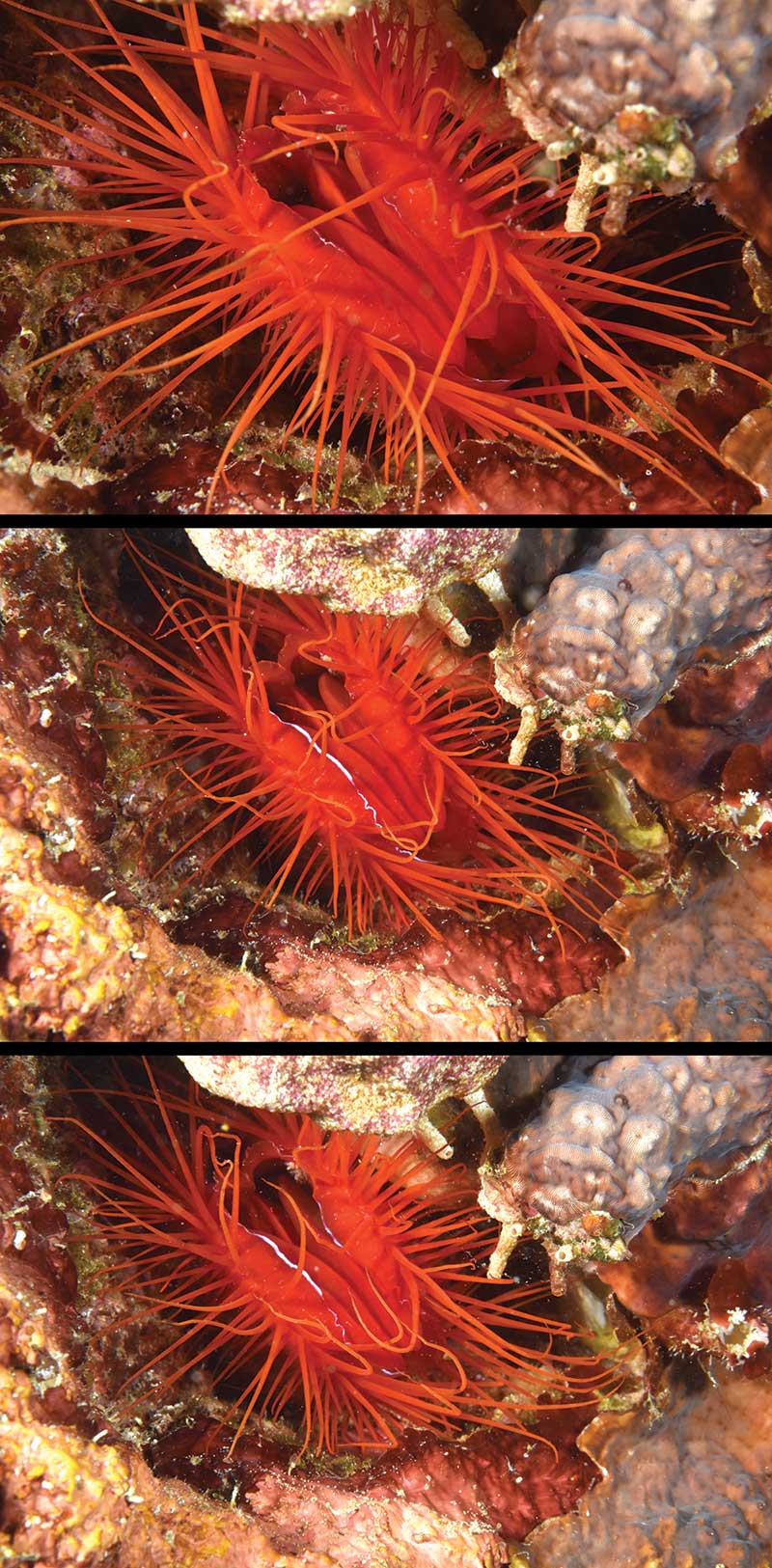How many clicks are too many?
By Michel Gilbert & Danielle Alary

Seemingly ifinite memory card capacity, large buffers, impressive firing rates: all things that may turn you into a lazy photographer. Is there a curse hidden in our favourite tools, or does gear make us better photographers?
We recently watched an interview with famed photographer Annie Leibovitz. She explained that digital cameras performed wonders in low light situations, something any underwater photographer will relate to.
This is the perfect example of the blessing of new technology and today, with the addition of AI in post-processing, we achieve levels of ‘perfection’ that were unattainable with silver-based photography.
But for specific reasons, no underwater photographer would turn back the clock and jump in the water with a 36-exposure roll of reversal film, a.k.a. slides.
One of those blessings arises from the capacity afforded by the memory cards; we can shoot hundreds of high-resolution images before filling them up. We typically use 64GB cards and this affords us upward of 600-900 images, depending on the camera. The weak part of the system often becomes strobe batteries capacity and, of course, our limited bottom time.

Rapid fire
DSLRs and especially advanced mirrorless cameras also fire at speeds normally associated with machine guns.
For example, Canon’s R6 full-frame mirrorless mechanical shutter shoots at 12fps (frames per second); relying on the electronic (silent) shutter it reaches 20fps. In the old days, it would have meant changing film every two seconds or so!!!
Most DSLRs and even more humble cameras will cruise at 5fps or 300 frames per minute! This is a lot of pictures. The buffer size does not allow this to happen but still, 5fps for 5- or 10-seconds results is an impressive number of images.
Of course, unless you shoot with a ton of ambient or continuous light (LED lamps for example), strobe recycling time becomes a significant limiting factor.
Pumping up the ISO while dialing 1/4 or 1/8 power on your strobe make these incredible firing speeds attainable.
Theoretically, it implies that one can push the shutter and follow a subject for a while, capturing zillions of frames. Will you inevitably catch the very image you have in mind, a specific behaviour or something that would not be otherwise possible? Maybe yes, maybe no.
Does this make you a lazy photographer who simply ‘sprays ’n prays’? Maybe yes, maybe no. One thing is for sure: it does not make you a better photographer.
We have a friend who came into our life when green and yellow boxes filled our cabinets. He is an exceptional photographer, albeit only on land (he’s not a diver; nobody’s perfect).
In those days, he would go out and bring 50 rolls of film on assignments where colleagues asked for 200. He was not chasing fast-moving targets. His trade was landscape, adventure, portraits, and some action. He shot a limited number of photographs but each of them carried a signature, a quality that impressed editors. Even in this day and age he is a man of few images. He can shoot as many frames as he wants, yet he still abides by his time-tested rules.
His mantra: “Outside of a once-in-a-lifetime occurrence or a specific action-oriented shot, planning, anticipating, visualizing, and timely capture results in fewer and better images.”
There is a case to be made for 20fps. However, in 99% of your photography, a single ‘click’ suffices; maybe three, but rarely more than that.
The late Ernie Brooks II, the consummate medium-format black & white underwater photographer, shot with a Hasseblad camera and 120-type film. Although it was available in 24-exposure rolls, he preferred the 12-exposure version.
Picture this: Ernie jumps in the water and surfaces, at the end of a dive, after shooting one or two frames out of an entire roll. He works only with available light; without even bringing a light meter.
Master Ernie
Using this technique, he produced some of the finest B&W underwater images ever made.
Some years ago, Canon gave him one of their top-tier DSLRs for a land photography project. Just like he did with his beloved Hasselblad, he walked around his subjects, considered available light, composition and then, eventually, press the shutter…once!
For Ernie, just like our friend, mastery of a craft rather than a lottery-type approach produced exquisite the images. As we think about Ernie and our friend a word comes to our mind, an expression that is not even part of most photography books: synthesis. One of the definitions of this word as written in Merriam-Webster’s is: the combining of often diverse concepts into a coherent whole.
The image as a coherent whole, summarizing, in a fraction of a second, a concept, a behaviour, a story; this is what photography is all about.
Fewer is better
Next time you feel like leaving your index finger on the shutter release, pause and think about the best moment to do it.
Commit to visualising the desired image long before you make it. Conceptualise and determine the required parameters that will materialize your idea.
And remember, spray’n pray may help sometimes, but it will never make you a better photographer.
PS: A final word from Danielle, the image editor in the family: useless spray’n pray only means more time spent looking at a computer screen rather than enjoying another beautiful dive. And in our case, it could mean a divorce!







